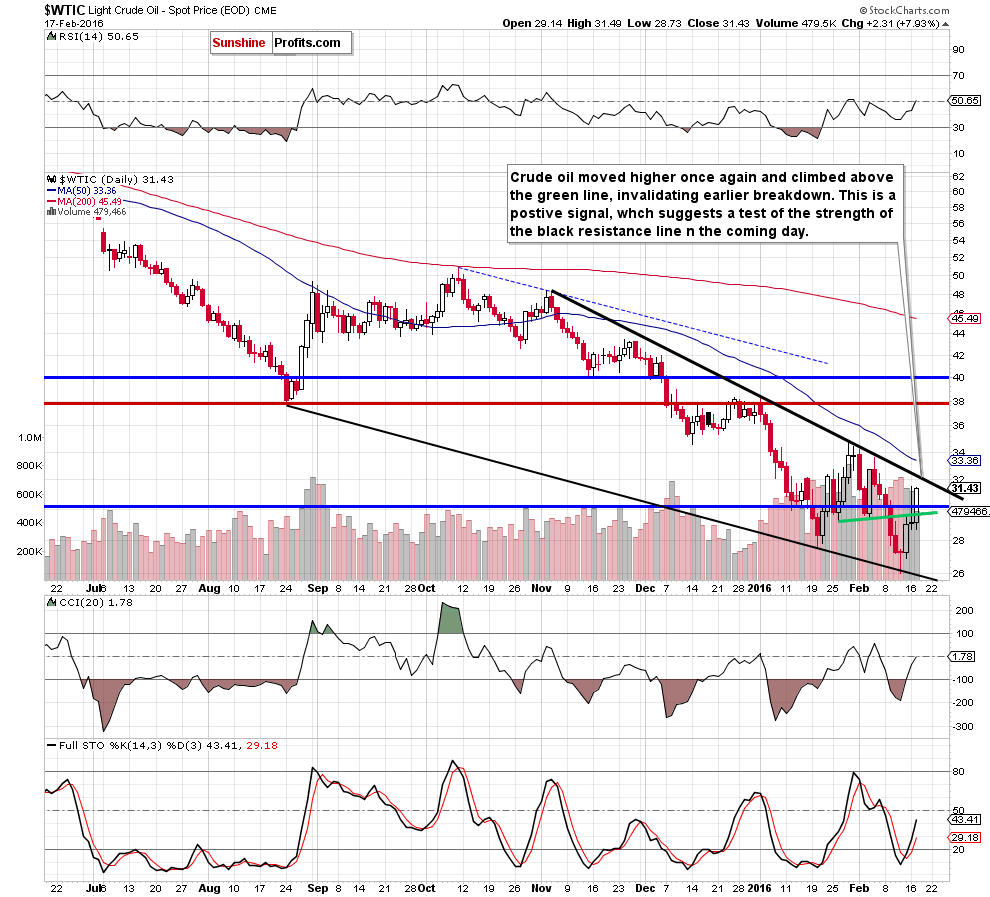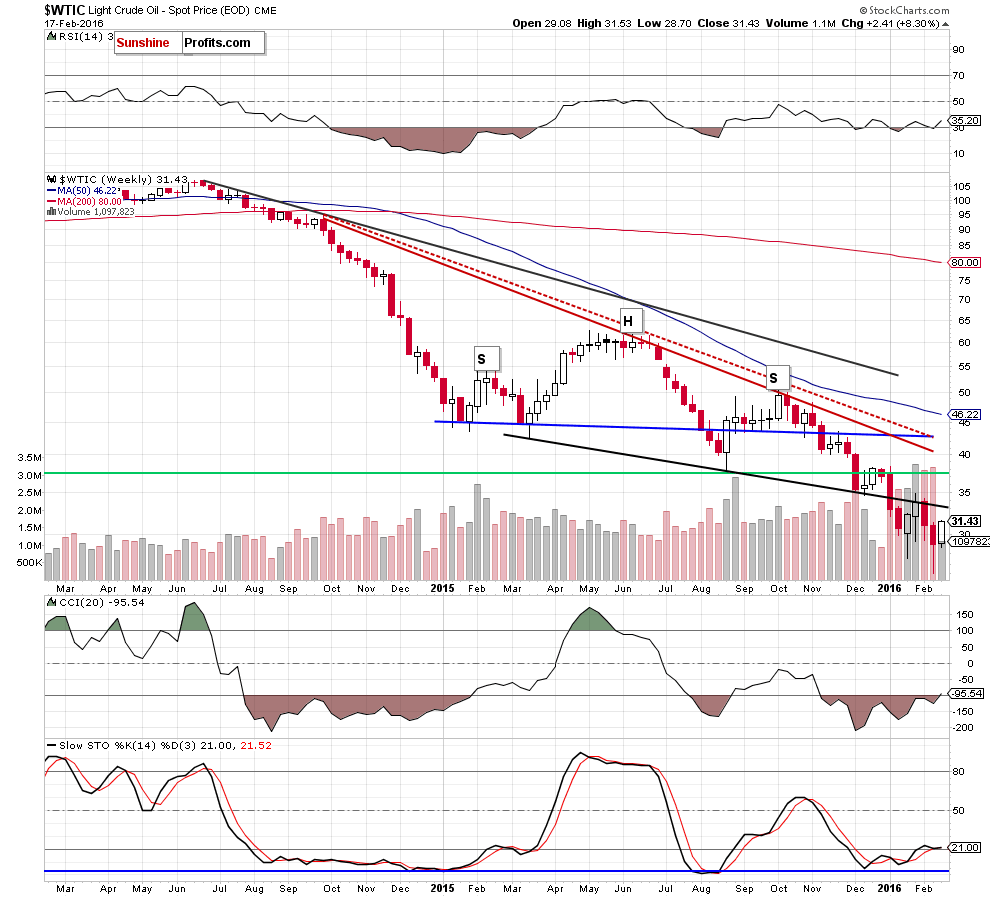Trading position (short-term; our opinion): Short positions (with a stop-loss order at $35.63 and a price target at $25.63) are justified from the risk/reward perspective.
On Wednesday, crude oil moved sharply higher after oil minister said that Iran would support any effort aimed at stabilizing oil prices. As a result, light crude came back above the barrier of $30 and invalidated earlier breakdown. How high could the commodity go in the coming days?
Yesterday, Iran Oil Minister Bijan Zanganeh surprised market participants when said that he would support a production "ceiling" to stabilize oil prices. Although he didn’t commit to participating in the deal, oil investors pushed the commodity higher, which resulted in a rally to an intraday high of $31.49. How did this move affect the technical picture of crude oil? Let’s examine charts and find out (charts courtesy of http://stockcharts.com).

Looking at the daily chart, we see that crude oil moved sharply higher once again, but this time oil bulls didn’t give up the gains and the commodity closed the day above the barrier of $30 and the neck line of the head and shoulders formation. In this way, light crude invalidated earlier breakdowns. This is a positive signal, which suggests that we’ll see another test of the strength of the black declining resistance line based on the Nov 4 and Jan 4 highs. As you see, this key resistance was strong enough to stop further improvement at the end of the previous month and also at the beginning of Feb, which suggests that we may see similar price action in the coming day. Additionally, it is worth noting that the size of volume that accompanied yesterday’s rally wasn’t significant, which doesn’t confirm the strength of the move.
How yesterday’s increase affect the medium-term picture? Let’s check.

From this perspective, we see that although crude oil moved sharply higher, the commodity remains under the neck line of the head and shoulders formation, which means that the pattern is underway and supports oil bears.
Summing up, although crude oil moved higher once again, invalidating earlier breakdowns under the barrier of $30 and the neck line of the head and shoulders formation (marked on the daily chart), the commodity remains under two key resistance lines: the black declining line marked on the daily chart and the neck line of the medium-term head and shoulders formation. Therefore, we believe that as long as this bearish pattern is underway lower values of the commodity are likely and short positions are justified from the risk/reward perspective.
Very short-term outlook: bearish
Short-term outlook: bearish
MT outlook: bearish
LT outlook: mixed with bearish bias
Trading position (short-term; our opinion): Short positions (with a stop-loss order at $35.63 and the price target at $25.63) are justified from the risk/reward perspective. The analogous levels for USO ETF and DWTI ETN are:
- USO initial target price: $6.67; USO stop-loss: $10.25
- DWTI initial target price: $513.31; DWTI stop-loss: $165.84
We will keep you – our subscribers – informed should anything change.
As a reminder – “initial target price” means exactly that – an “initial” one, it’s not a price level at which we suggest closing positions. If this becomes the case (like it did in the previous trade) we will refer to these levels as levels of exit orders (exactly as we’ve done previously). Stop-loss levels, however, are naturally not “initial”, but something that, in our opinion, might be entered as an order.
Since it is impossible to synchronize target prices and stop-loss levels for all the ETFs and ETNs with the main market that we provide this level for (crude oil), the stop-loss level and target price for popular ETN and ETF (among other: USO, DWTI, UWTI) are provided as supplementary, and not as “final”. This means that if a stop-loss or a target level is reached for any of the “additional instruments” (DWTI for instance), but not for the “main instrument” (crude oil in this case), we will view positions in both crude oil and DWTI as still open and the stop-loss for DWTI would have to be moved lower. On the other hand, if crude oil moves to a stop-loss level but DWTI doesn’t, then we will view both positions (in crude oil and DWTI) as closed. In other words, since it’s not possible to be 100% certain that each related instrument moves to a given level when the underlying instrument does, we can’t provide levels that would be binding. The levels that we do provide are our best estimate of the levels that will correspond to the levels in the underlying assets, but it will be the underlying assets that one will need to focus on regarding the sings pointing to closing a given position or keeping it open. We might adjust the levels in the “additional instruments” without adjusting the levels in the “main instruments”, which will simply mean that we have improved our estimation of these levels, not that we changed our outlook on the markets.
Thank you.
Nadia Simmons
Forex & Oil Trading Strategist
Przemyslaw Radomski, CFA
Founder, Editor-in-chief
Gold & Silver Trading Alerts
Forex Trading Alerts
Oil Investment Updates
Oil Trading Alerts



